#olentzero
Explore tagged Tumblr posts
Text





MERRY (late) CHRISTMAS, HANUKKAH, YULE OR WHATEVER YOU CELEBRATE (if you celebrate anything at all)!!!
Today I bring you Alba and Floyd as Mari Domingi and Olentzero, two characters from the Basque Christmas, singing basque Christmas carols (bc Alba/Alf is canon basque and I headcanon Floyd to also be from the Basque Country, like me :D) Also, idk why the quality in the first photos is so bad :"[

(Also, drawing of Dr. Teeth I did for the muppetational may, because he has Olentzero vibes and bc I saw it in a dream).
ESPERO DUT GABON OSO ONAK PASATU IZANA ETA URTE BERRI ONA IZAN, LAGUNAK! :D
#the muppets#muppets fanart#dr teeth and the electric mayhem#oc art#traditional art#oc#christmas#olentzero#olentzero eta Maridomingi#euskal herria#floyd pepper#Spotify
22 notes
·
View notes
Text





🎅🎄 Personnages du folklore de Noël dans différentes cultures. Partie 3
#christmas#noel#charadesign#character design#drawing#art#tio de nadal#caga tio#caganer#kallinkantzaros#mari lwyd#olentzero#mari domingi
14 notes
·
View notes
Text
I was trying to look around to see if I could find some more information about Père Noël in its pre-Americanized incarnation online, but unfortunately most websites share the misinformation that "Père Noël" only existed from the 50s onward and was a French invention... No. [Note: I know books exist folks, but I precisely wanted to do a web research first]

There is only one website that does not share this idea and does identify Père Noël as a typical French figure that was then overtaken by the American Santa Claus, and the most fascinating thing is that it points out (despite previous sources I shared claiming "Père Noël" was first recorded in literature in the mid-19th century, by people describing their youth around the turn of the 18th-19th century) that Père Noël seems to have existed since the Middle-Ages, with texts referring to "Père Noël" or to "Monseigneur Noël". But it does recognize that the Père Noël traditions really boomed in the 19th century and were associated with the bourgeoisie of the time...
The website in question however is mostly focused on the various local, regional incarnations of the gift-giver - because as with many things in France, this tradition is rather a set of various regional and localized specificities that were ultimately synthetized into one entity.
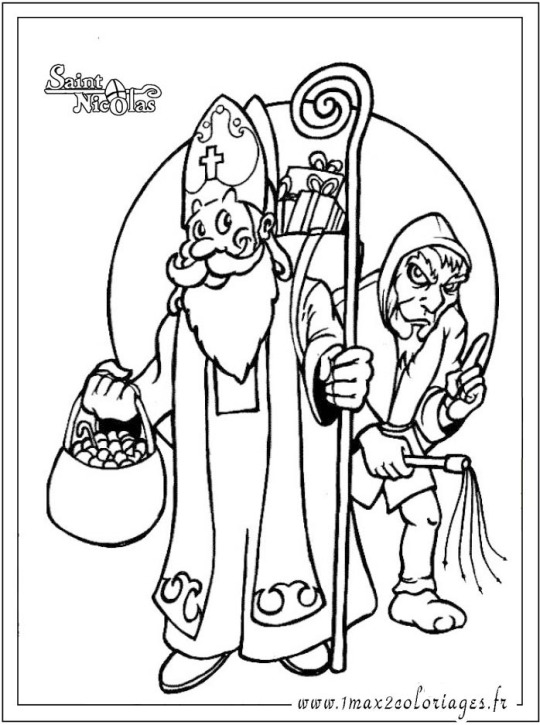


It reminds that in the Lorraine and Alsace region, the Germanic cultures and German influences make it so that Saint Nicholas and Christkindl are still the main gift-givers. In Lorraine it is Saint Nicolas who is most honored (he is after all the saint patron of Lorraine). Appearing in his bishop outfit that makes him look a lot like Santa Claus (thick white beard, large clothes of red and white), every 6th of December he brings gifts and treats to nice children - while naughty children are confronted by his dreaded companion, Père Fouettard dressed in blacks, who beats up with a stick bad children. Saint Nicolas is also still strongly celebrated in the North of France (aka, what is above the Parisian region, because despite what some foreigners believe, Paris is not part of the North).

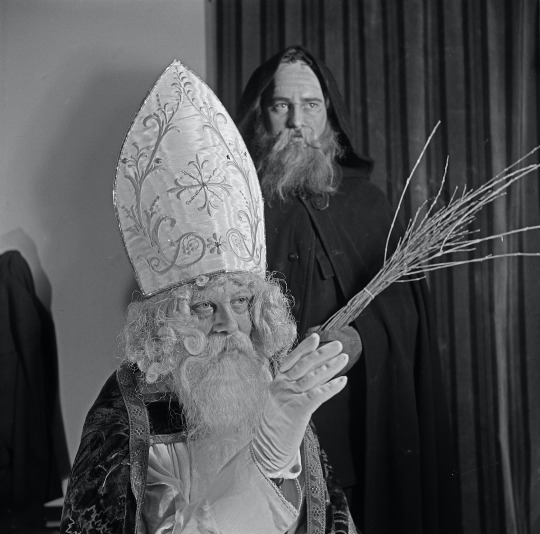
While in Alsace it is the Christkindl that still goes strongly, with Hans Trapp as its own Père Fouettard. The website briefly reminds that Christkindl is an avatar/incarnation of the Child-Christ, or Baby Jesus, that ended up being fused with the 23rd of December Saint, Sainte Lucie (Saint Lucia), resulting in this unique Christmas figure appearing as a woman dressed in white with a crown made of fir branches topped by four candles. It also reminds how Christkindl stays a symbol of Protestant end-of-the-year celebrations, as they pushed the Christkindl figure to oppose and replaced the Catholic celebrations of Saint Nicolas. Finally, there is an Alsace-specific legend that claims Hans Trapp actually originated as an Alsacian lord that tyrannized his people - Hans von Trotha, the 15th century lord of Wissembourg.
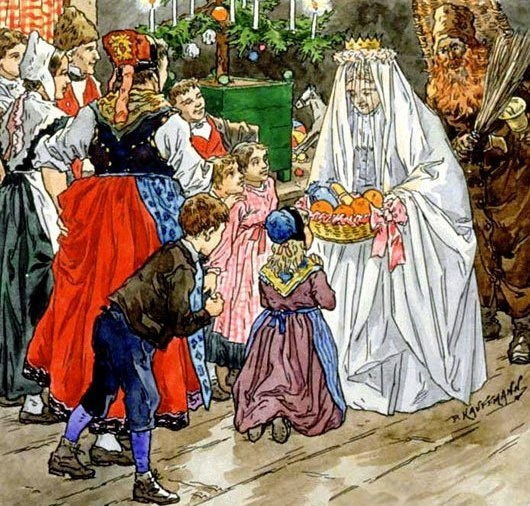

[Given the Alsace region has a lot of website pages about its traditions I'll place here in brackets informations from other websites:
The Christkindl, also written Christkindel or Chriskindla, is a Christian figure that is supposed to be an embodiment of L'Enfant Jésus, Child Jésus (the name comes from Christ-Kindel ; Christus-Kindlein, Christus als Kind), but definitively was influenced by Saint Lucia, who is very big in Scandinavia. In fact, Saint Lucia and the Christkindl look a lot like each other - female entities dressed in white with a crown of candles... Though the Christkindl can appear both as an adult woman and as a little girl, and also tends to have white veils. People tend to also find in Christkindl remnants of the Germanic goddess Berchta. No need to tell you that the Christkindl is big in all parts of the world influenced by German culture - Germany, Austria, northern Italy, Croatia, Slovenia, Switzerland, Czech Republic, and even some parts of Brazil, the ones where there was strong German imigration.
The Christkindl appeared in the 16th century with the Protestant Reform. Up until this point the day of Saint Nicolas was a very big thing in Alsace - saint-patron of school students, he offered good children mandarines and "manala" (a brioche in shape of a child). But the Protestants did not agree with this (Protestants were known to strongly dislike saints in general), and so they replaced the saint with the Christic figure of Christkindl, while keeping Père Fouettard/Hans Trapp (whose job was to threaten with stern lectures naughty children... or take them in a bag to abandon them in the deep dark woods). The change occured over the 16th century, from 1530-1536 (last mentions of Saint Nicolas in Alsace) to 1570 (first mention of Christkindl, when the Klausemärik was replaced by Christkindelmärk). In fact, Christkindl still has some Saint Nicolas traits - she also goes around with a donkey, named Peckeresel, which carries two bags, one for the treats (mandarines and bredalas), one for the whips. People left hay or carrots for the donkey to eat by the front door. Pastor Johannes Flinner made a strong public attack against saint Nicolas in Strasbourg during the "cultural transition", by pointing out that distributing gifts to all should be the prerogative of the Christ and no one else.
During the 20th century the Christkindl lost popularity in Alsace (jee, I wonder why France would like to bury Germanic traditions in the century of World War II) - but it returned in the traditions from the 1990s onward.
Fascinatingly, despite being supposedly a Christ-figure of an angel, the Christkindl, or White Lady, is also frequently called in alsace, a "fée", a fairy, la fée de Noël, the Christmas fairy. It doesn't help that she sometimes carry around a wand with a star at the tip, that is strikingly reminding of the stereotypical fairy-wand. Another irony of fate - despite the Christkindl being brought over to replace Saint Nicolas, the two currently still coexist in Alsace thanks to people not wanting to abandon the good old bishop. A third fun fact: originally the Christkindl could be played as much by women as by men, due to being a truly androgynous entity. From the 16th century onward, the Saint Nicolas celebrations were replaced in Alsace by parades of teenagers of both sexes dressed in white, going from door to door to give gifts and sing Christmas songs. However you can't have teenage boys and girls go around late at night without getting some problems... And those "Saint Nicolas hook-ups" were a real problem in Alsace, you have records from the 17th and 18th centuries pointing out how authorities have to try to refrain all the Christkindl from... well you know.]
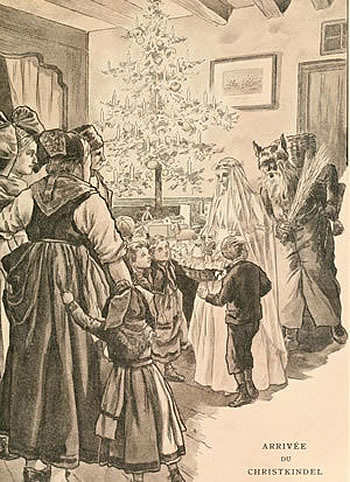


The next entity presented is the famous Pays Basque character of Olentzero, whose appearance is that of a coal-man. Well a bizarre coal man - he has a bag filled with coal in one hand, a sickle in the other, a large beard on his face and a béret on his head. According to the Basque-version of the Nativity lore, he lived at the top of the mountains but saw in the sky the announcement of the birth of Kixmi (Basque name for Jésus), and he descended from his mountains to announce the good news. While he is the gift-giver of Pays Basque, leaving gifts for children in the night between the 24th and 25th of December, entering in the house by the chimney ; he is also a bogeyman figure, as he was a scary-looking man who was said to take away in a bag naughty children. As with everything Basque, Olentzero is actually a pre-Christian figure, as the very name of the character is related to the "pagan" winter solstice celebrations of the old Basque religion.
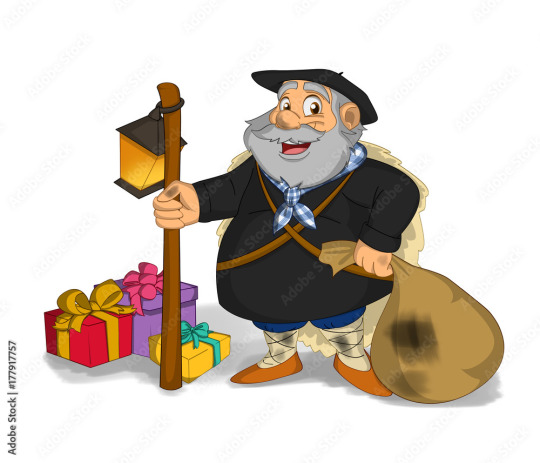
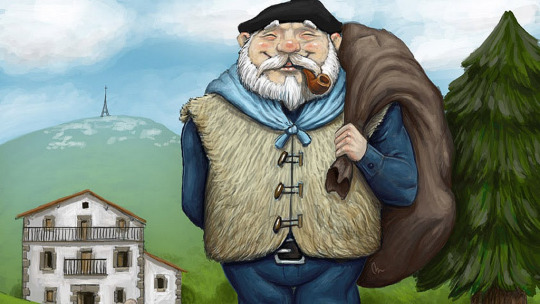
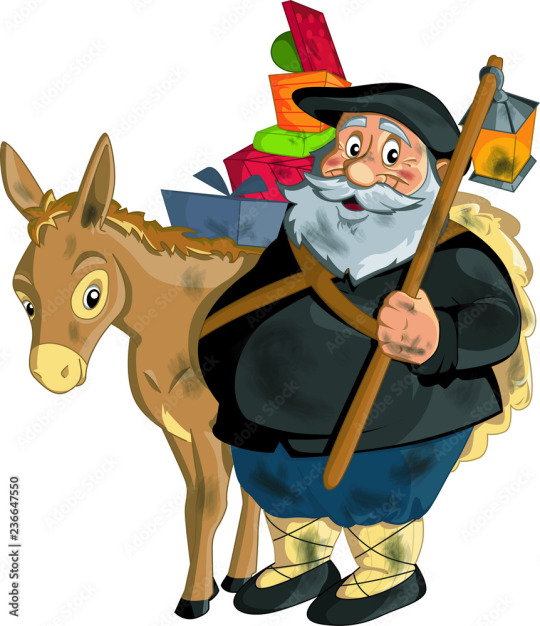
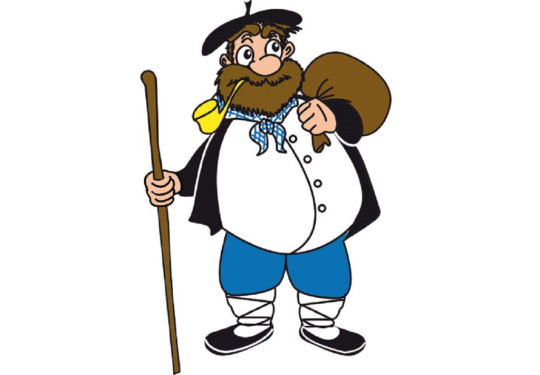
[Again, time to bring some more information from other websites to make sure I give a more complete portrait:
Long story short, because the Basque folklore is very well documented and I can't spend too much time on this, the Olentzero (or Olentzaro, Orentzaro, Omentzaro, Orantzaro...) is at the same time the Basque name for Christmas and the Basque figure of the coal-man that brings gifts during Christmas. He is supposed to be a grotesque character - rude, fat, dirty, gluttonous, his face blackened by soot, with worn-out clothes... He is basically a caricature of mountain-men and forest-men. Sometimes he is even given monstrous traits such as "having as many eyes as there are days in the year, plus one" - which is reminding of a French being of the New Year folklore called L'Homme aux Nez who also has as many noses as there are days in the year...He typically holds branches of gorse in one hand and a sickle in the other.
He comes down from the mountains, enters houses by chimneys, goes into the kitchen once everybody goes to sleep to eat all leftover food, and he warms himself by the fire - either you had to leave a log burning just for him, either he used the flames of the fire to burn his gorse branches. In fact, "olentzero" was also the name of a special log that was left bruning in the fireplace from Christmas to the 1st or 6th of January. This theme of the "coal man" of winter or the burning of branches all answers to a deep motif of bringing back light and heat in the heart of the cold and the dark. Him holding a sickle has made people draw parallel between him and the figure of Saturn/Kronos.
In fact, there is an old tradition, long before the Olentzero was embodied by a disguised man or by a mannequin paraded through the villages, to embody the character simply by the sickle. The sickle hanged by the chimney, as a threat to all disobedient children, to all lying children, and to all children that refused to go to bed. Another symbol of the Olentzero, outside of the sickle and the coal-sack, is a wine-bag or wine-bottle that he carries around, because to add to the grotesque he is also a drunkard, and according to stories it is because he gets often drunk that his wife regularly beats him. (Because yes the Olentzero has a wife, a character named Mari Domingi and who is typically depicted wearing a medieval regional outfit). However it seems that all this grotesqueness is simply due to the Olentzero being a character from the old Basque mythology that got Christianized - think of how the Dagda of Celtic mythology also got more buffoonish/clownesque/grotesque as time passed. We do know that the roots and origins of the character lie in the valley of Bidassoa...)
Today gone is the creepy bogeyman and grotesque glutton ; the Olentzero has evolved into a kinder, nicer, cleaner incarnation that is closer to the Père Noël traditions. For example he now parades through streets during the day, riding a horse (pottok) or by foot, giving children candies and sweets (including fake-coal actually made of sugar) ; and the legend claims he goes down from the mountain to offer coal and wood-logs to the poor families that can't afford fuel for their fire]


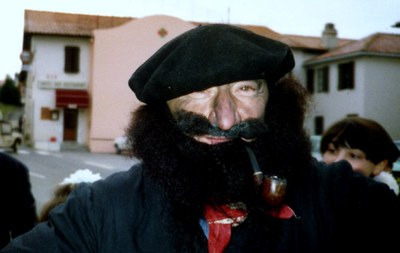

And finally, we find back our good old Père Janvier! Here we have most of the same info as previous. Père Janvier was a Bourgogne character, most present in the Morvan and Nivernais regions up until the 1930s. He brings gifts in the night between the 31st of December and the 1st of January by going through the chimney - chimney which must be decorated with holy and mistletoe. Père Janvier (Father January) typically looks like a skinny old man with a long white beard, dressed in a brown monk-like robe, and he is usually bent due to wearing on his back a heavy wicker basket filled with toys. And he too has for companion the Père Fouettard.
Most interestingly, the website mentions "Père Janvier variations" across France, most notably the Savoie character of Père Chalande, and the Normandie character of Barbassioné.


More information from other website. Le Père Chalande (or Papa Chalande, Daddy Chalande) was indeed a figure of the Savoie region, but also of the Dauphiné, and he was also present in Geneva. Martyne Perrot, in her book "Faut-il croire au Père Noël? Idées reçues sur Noël" even lists the area of action of this figure as: Savoie, Suisse romande, Bresse, Forez, Ardèche, Gard, Lozère and Hérault. He is basically identical to Père Noël because "Chalande" is just an old word for "Noël" (Christmas) in the regional language known as arpitan.
There was a traditional song that went as such: Chalande est venu / Son chapeau pointu / Sa barbe de paille / Cassons les anailles (noisettes) / Mangeons du pain blanc / Jusqu’à Nouvel An. / Il monte dans sa chambre / Il trouve une orange / Il la pluche / Il la mange / On l’appelle le petit gourmand. / Il descend les escaliers / Il se casse le bout du nez / Il va chez le cordonnier / Se faire mettre une pièce au nez / Quand il est malade / Il mange de la salade / Quand il est guéri / Il mange des souris/ Toutes pourries !
I can't translate the full song, but it refers to various traditions. For example leaving an orange for Père Chalande ; Père Chalande wearing a "beard of straw and a pointy hat" (leftovers of Saint Nicolas, especially the pointy hat) ; Père Chalande giving "anailles" (walnuts) to children ; and the habit of placing inside the Christmas log (real log of the fire) chestnuts, so that the burning of the Christmas log doubled as the cooking of the wintery treats. Raymond Christinger wrote in 1965, in a set of research about Geneva folklore, an article studying the character of Chalande, if you know how to read French: here.
While doing Chalande research I stumbled upon a Swiss theory brought forward by a journalist named Bernard Léchot - I don't know how accurate this is when it comes to actual evolution of Christmas figures, but here it is. According to him, the Christmas archetype of the "Old Man" actually comes 18th century Germany. In this era of rationalism, the German Protestant landgraves decided to introduce some laicity to their country, and so cut-off all characters close to Christianity from their Christmas celebrations (from Saint Nicholas to Christkindl). As a result, pagan figures returned, including the Old Man in the shape of Weihnachtsmann. Which then spread to other European countries, each land creating its variation: Bonhomme Noël in France, Father Christmas in England, Père Chalande in Savoie.
As for the Barbassioné of Normandie, I found nothing about him. As in every says it is the Normandie name of Père Noël, but he doesn't have any specific thing to his character.

To conclude, I will link you to a page documenting a Père Noël/Christmas beings exposition that collected various visuals of the history of the Christmas gift-givers through time, right here.
And through it you will see the evolution from the "Scandinavian ancestors" (Thor and Odin) and Saint Nicolas (celebrated in Germanic countries and the Alsace region), to the American Santa Claus and the British "Old Father Christmas", passing by the Germanic Knecht Ruprecht, the also Germanic Weihnachtsmann, the Christinkindel (of Germany, Belgium and Alsace), the Jultomte of Sweden, and the Enfant Jésus/Child-Jesus of France and Italy...
Without forgetting the French Bonhomme Noël, the Italian Befana, the regional ancestors of Père Noël (Tante Arie, Père Chalande, or the Breton Ted Nedelec), the Russian Ded Moroz, and Mère Noël (Mother Christmas)... With additional sections about Santa Claus in advertisements, the theme of "outlaw Father Christmas", Père Noël during the World Wars, and more...
#french folklore#father christmas#père noël#saint nicolas#christkindl#père chalande#père janvier#christmas folklore#olentzero#basque folklore#hans trapp#père fouettard#christmas art#santa claus#christmas
20 notes
·
View notes
Text
Olentzero eta Maria Domingi


3 notes
·
View notes
Text
Merry Christmas



Estra:


#drawing#merry christmas#snegurochka#mrs. claus#santa claus#krampus#pehta#padigueiro#olentzero#jack frost#befana#badalisi
1 note
·
View note
Text

0 notes
Text

0 notes
Text

https://vamosaaprenderespanol.blogspot.com/2024/12/sabias-que-olentzero.html
#olentzero#paísvasco#españa#spain#Sabíasque#curiosidades#culturaespañola#culturahispana#costumbres#tradiciones#español#lenguaespañola#espanhol#spanish
0 notes
Text

MERRY XMAS!
1 note
·
View note
Text

Olentzero the toy maker.
#giant#giants#toys#christmas#Olentzero#spacecraft#rocket ship#fireplace#brick#painting#graphite#pencil#sketch#doodle
1 note
·
View note
Note
Can you shed any light on how Santa came to give naughty children coal, when coal used to be a reasonably useful present?? I tried googling it but nothing that came up seemed researched better than folk wisdom, or modern-day people trying to make it make sense.
Considering that the holiday has come to dominate upwards of 1/12 of the cultural calendar every year in much of the world - there has been shockingly little academic research done on the history of Christmas and Christmas traditions. So unfortunately folk wisdom is kind of all we have on this subject.
Coal has long been associated with various cultural figures who fall under the "winter gift-bringer" archetype. The Italian witch-like figure Befana brings coal or ashes to bad children, and the Basque Olentzero was traditionally a charcoal burner by profession. However, as most folk-lore consists mainly of unwritten cultural tradition, it is very difficult to determine exactly when and how these figures developed, and what, if any, influence they had on one another.
(For the duration of this I'm going to dub any item brought by Santa as a punishment as an 'anti-gift' for a lack of a better term. Also, the following information is specific to the continental US, as that's the area I most focus on.)
To begin with - coal, in the anti-gift sense, does not necessarily refer to valuable high-grade anthracite. It could just as easily refer to low-grade industrial coal or even charcoal. It was also given in such small quantities (small enough to fit in a child's sock, as that's what stockings were originally) as to be worth almost nothing, no matter the quality.
I actually tend to agree with what most modern articles written on this subject theorize - which is that coal was just a conveniently located item that every household had. Stockings were traditionally hung on the mantle or around the stove, so the coal scuttle was right there for any disgruntled parents looking to punish their child's misbehavior.
This theory seems to be supported by other anti-gifts I've come across in Dear Santa letters which appear to be overwhelmingly fireplace related - ashes, sticks, sand (commonly used in fire buckets) and once even buffalo chips.
Ashes in particular were a very common anti-gift in much of the US in the late 19th/early 20th century. Though often the belief was that Santa would throw ashes in your eyes if you peek at him, rather than leave them in your stocking for bad behavior.
By far the most common non-fireplace-related anti-gift I come across in Dear Santa letters is switches (as in branches/rods used for corporal punishment). I've only done the scantest of formal documentation on the subject but, just given my general observations, - I'd say that switches were just as common of an anti-gift as coal, if not more so, up until the mid-20th century when corporal punishment/spanking began becoming less culturally acceptable. I have also noted that switches were noticeably more common in the Southern US, where it is not uncommon to see them mentioned in Dear Santa letters well into the 21st century (though my attempts to document any very recent data on this has been somewhat complicated by the introduction of the Nintendo Switch.)
Coal being a relatively useful and valuable item seems to have been a joke for as long as it has been a tradition, and it is not at all uncommon to see adults pointing out that fact - especially during strikes and shortages.

Even in times of scarcity, I suspect most stocking coal ended up right back in the coal bucket, as I can't imagine most children were interesting in keeping it - thus costing the parents (or Santa) absolutely nothing.
Was coal the traditional anti-gift where any of you grew up, or was it something else?
#sorry for the late response#I accidentally put this in my drafts instead of my queue#christmas#traditions#history#coal#dear santa#asks#long post
187 notes
·
View notes
Text

Pues ya tengo la carta lista!!
Y por si acaso se la voy a mandar también a los reyes magos, al caga tió, al apalpador, al Olentzero, al niño Jesús, al camello de mi barrio y ya como último destello de esperanza, a la seguridad social
6 notes
·
View notes
Text
Mythic Creatures by Culture & Region
Part 3: Europe (Basque, Rome, Viking, Great Britain)
This list documents mythological and folkloric creatures of Ancient Europe, the British Isles and Scandinavia as found on Wikipedia.
European creatures from Eastern Europe, France, Germany, Italy, Greece etc. will be listed in a separate post. The same goes for Biblical creatures or creatures from Abrahamic religions and Goetia literature. The full list of creatures is here.
Basque
Basque people live in what is today northern Spain. Their language is the only surviving language in Europe that isn't part of the Indo-European family tree, likely because the Basques live in secluded mountain areas. I have listed some deities alongside creatures, but this is a full list of Wikipedia's Basque creatures, not a full list of Wikipedia's gods/goddesses/deities for Basque culture.
Aatxe; Aide air goddess; Akerbeltz; Amalur; Basajaun; Eate (Basque god); Egoi; Eki (Basque goddess); Fountain Women; Gaizkiñ; Gaueko; Herensuge; Ilargi; Inguma; Iratxo ; Iratxoak; Jentil; Lamignak; Mairu; Minairó also Catalan; Odei; Olentzero; Orko; San Martin Txiki; Tartalo
Proto-Indo-European
Proto-Indo-European (or PIE) is the reconstructed ancestor to all major European languages, excluding Basque and languages from later diasporas.
Dʰéǵʰōm; Proto-Indo-European Myth; Double-headed eagle maybe not PIE but Bronze Age
Roman
Abarimon (Pliny the Elder, whose source is supposedly a land surveyor of Alexander the Great); Aborigines_Roman myth\; Achlis (Pliny the Elder); Caligo, see Achlys; Aegipan (Pliny the Elder locates them in Libya); Albruna Germanic seeress attested by Tacitus; Amazons, Amazons (List); Anguiped also Greek and Iranian.; Antichthones; Astomi Pliny the Elder; Aura; Bonnacon Pliny the Elder; Caca; Caeneus; Caladrius; Calingae Pliny the Elder; Camilla; Catoblepas Pliny the Elder; Cimbrian seeresses mentioned by Strabo; Crocotta Strabo and Pliny the Elder; Cupid; Di Penates; Echeneis Pliny the Elder; Ethiopian pegasus Pliny the Elder; Faun, Faunus ; Faunae, Fauni; Faustulus; Forest Bull Pliny the Elder; Fraus; Genius; Genius loci; Gorgades; Hellusians Tacitus claims they live beyond the Finns; Hircocervus; Hooded Spirits; Hydrus Pliny the Elder; Ichneumon Pliny the Elder; Ichthyophagoi; Indus worm; Iphis; Kings of Alba Longa; Lampedo Amazon; Lares; Lares Familiares; Lemures; Mandi; Manes; Manticore; Monoceros Pliny the Elder; Monopod; Odontotyrannus; Orcus; Pandi; Phoenix; Phthisis; Pyrausta Pliny the Elder; Querquetulanae; Remora; Salamander; Seps; Silvanus; Strix; Syrbotae Pliny the Elder; Tarand; Theow Pliny the Elder; Unicorn; Wild Man, Wild Woman ; Wild Men, Wild Women; Yale
Etruscan
Charun; Orcus; Tuchulcha; Vanth; Vegoia
Britain
Apple Tree Man; Ascapart giant from chivalric romance dating to 1300s; Asrai Cheshire and Shropshire; Barghest north England; Beast of Dean; Beithir; Billy Blind England and Scottish Lowlands; Black Annis; Black Dog; Black Shuck; Bluecap; Blunderbore; Bogeyman; Boggart; Bogle Northumbrian; Brag Northumbrian; British Wild Cats; Brown Man of the Muirs anglo-scottish border; Brownie ; Brownies; Bucca Cornish; Bugbear; Burryman; Butter Sprite; Calygreyhound; Cat-sìth; Cauld Lad of Hylton; Inspiration/Directories/Bestiary (Myth and Legend)/A-Z/Changeling|Changeling; Christchurch Dragon; Cirein-cròin; Cock Lane Ghost; Cockatrice (explicitly British); Cofgod; Colbrand (giant); Colt pixie; Cormoran (giant); Dando's Dogs; Drummer of Tedworth; Dun Cow; Dunnie Northumbrian; Elder Mother; English Fairies; Ettin; Fairy story (Northumbria); Fetch; Finfolk Orkney; Girt Dog of Ennerdale; Goram and Vincent (giants); Grendel; Grendel's Mother; Grimalkin; Grindylow; Gytrash; Habetrot (Northumbrian?? border counties between England and Scottish Lowlands); Hob; Hobbididance; Hobgoblin ; Hobgoblins; Imp; Jack and the Beanstalk; Jack Frost; Jack in the Green; Jack o' Legs; Jack o' the bowl; Jack the Giant Killer; Jack-In-Irons; Joan-in-the-Wad; Kilmoulis Anglo-Scottish border; Knocker; Knucker; Korred; Krabat; Lambton Worm; Lantern Man; Lazy Laurence; Lubberfiend; Martlet; Mary Lakeland (accused witch); Mermaid of Zennor; Morgan le Fay; Morgawr; Nanny Rutt; Nelly Longarms; Nuckelavee Orkney; Nuggle Shetland; Pantheon_the_creature; Peg Powler; Penhill Giant; Pictish Beast Picts; Pillywiggin; Pixie; Portunes; Púca; Puck; Puck_Shakespeare; Queen of Elphame (Northumbrian?? border counties between England and Scottish Lowlands); Redcap English-Scottish border; Screaming skull; Sea Mither Orkney; Sebile; Sheela na Gig; Shug Monkey; Simonside Dwarfs; Sockburn Worm; Spriggan ; Spriggans; Sprite ; Sprites; Stoor worm; Sweet William's Ghost; Tangie Orkney and Shetland; The Black Dog of Newgate; The Elder Mother also Scandinavian; The Hedley Kow Northumberland; The King of the Cats; The Laidly Worm of Spindleston Heugh Northumbrian; The Queen of Elfan's Nourice; Thunderdell Cornish; Tiddalik; Tom Hickathrift; Tooth Fairy; Tree Elves; Trow; Unicorn; Wight; Wild Man, Wild Woman ; Wild Men, Wild Women; William of Lindholme; Worm of Linton; Wyvern; Yallery Brown
Isle of Man
Adene, elves?; Arkan sonney "lucky piggy"; Ben-Varrey see "Mermaid"; Buggane; Cailleach; Fenodyree; Glashan; Glashtyn; Jimmy Squarefoot; Moddey Dhoo; Mooinjer Veggey; Sleigh Beggey; Tree Elves; Water Bull
Irish
Abarta either Tuatha or Fomorian (depends on account); Abcán the poet and musician of the Tuatha, a dwarf (in stature?); Abhartach; Aes Sidhe; Aibell, an elf queen (banshee, ruler of a fairy mound); Aillen, the "burner" a monstrous Tuatha; Aos Sí; Badb; Balor; Bánánach; Banshee; Baobhan Sith; Biróg a lheannan sidhe; Bodach also Scottish; Bran and Sceólang; Brendan the Navigator; Cailleach; Carman; Cas Corach; Cat-sìth also Scottish; Cathbad; Cethlenn; Cichol Gricenchos; Clíodhna; Clurican; Conand; Crom Cruach; Cù-sìth; Dobhar-chú; Donn Cúailnge; Dullahan; Each-uisge; Echtra; Elatha; Ellén Trechend; Enbarr; Ethniu; Failinis; Fear Doirich; Fear gorta; Finvarra; Fionn mac Cumhaill; Fionnuala; Fir Bolg; Fir Darrig; Fomorian; Gancanagh; Garb mac Stairn; Glas Gaibhnenn; Immram; Irish Mythic Creatures; Iubdan; Joint-eater; Kelpie; Leprechaun; Les Lavandières; Lhiannan-Sidhe; Liban; Inspiration/Directories/Bestiary (Myth and Legend)/A-Z/Manannán mac Lir|Manannán mac Lir; Medb (Queen Maeve); Merrow ; Merrows; Mongfind; Muckie; Mug Ruith; Nel; Niamh; Oilliphéist; Onchú; Pillywiggin; Púca; Sadhbh; Salmon of Knowledge; Scáthach; Selkie; Sengann; Seonaidh; Sheela na Gig; Sidhe; Sìth also Scottish; Sluagh also Scottish; Sovereignty goddess; Sreng; Swan Maiden; Tethra; The Morrígan; The Voyage of Bran; The Voyage of Máel Dúin; The Voyage of the Uí Chorra; Tlachtga; Tuatha dé Danaan; Werewolf; Werewolves of Ossory; Wild Man, Wild Woman ; Wild Men, Wild Women; Wyvern allegedly Irish; Cymidei Cymeinfoll
Scotland
Am Fear Liath Mòr; Red Cap; Bauchan; Bean-nighe; Beast of Beinn a' Bheithir; Betram de Shotts; Biasd Bheulach; Billy Blind lowlands and England; Blue Men of the Minch; Bodach also Irish; Boobrie west coast Scottish lochs; Broichan wizard of Pictland (north Scotland); Brown Man of the Muirs anglo-scottish border; Brownie ; Brownies; Cailleach; Cain bairns; Ceasg; Cù-sìth; Each-uisge; Fachan; Fuath; Ghillie Dhu; Gigelorum; Glaistig; Gormshuil Mhòr na Maighe; Kelpie also Irish; Lavellan; Les Lavandières; Ly Erg; Maggy Moulach; Morag; Muc-sheilch; Nicnevin; Pech; Red Cap; Seelie; Shellycoat; Sìth also Irish; Sithchean Hebrides; Sluagh; Spey-wife; Tam Lin; The Green Man of Knowledge; Water Bull; Water Horse; Wild Haggis; Wirry-cow; Wulver
Welsh
Adar Llwch Gwin; Adar Rhiannon birds from Mabinogi and Welsh Arthurian tales; Aderyn y corff, corpse bird, portent of death; Afanc; Arawn; Bendith y Mamau see Tylwyth Teg; Blodeuwedd; Brenin Llwyd; Bres Tuatha; Buwch Frech; Bwciod; Cath Palug; Ceffyl Dŵr; Coblynau; Cŵn Annwn; Cyhyraeth; Cymidei Cymeinfoll; Cythraul; Dormarch; Gwagged Annwn or Gwragedd Annwn; Gwrgi Garwlwyd; Gwyllgi; Gwyllion; Gwyn ap Nudd; Henwen; Idris Gawr; Jack o' Kent; Les Lavandières; Llamhigyn Y Dwr; Maelor Gawr; March Malaen; Mari Lwyd; Morgen; Sleigh Beggey also Manx; Swan Maiden; Twrch Trwyth; Tylwyth Teg; Welsh Dragon; Welsh Giant; White dragon; Wild Hunt; Wyvern; Y Ladi Wen; Ysbaddaden; Ysgithyrwyn
Scandinavian (Viking, Sweden, Norway, Denmark, Iceland)
Æsir; Æsir–Vanir War; Alberich in Thidrekssaga written in 1250 in Norway, possibly based on a Plattdeutsch original (also appears in German Nibelungenlied from 1200 in Passau, Bavaria and Ortnit from 1230s Germany, Strassburg; Álfablót sacrifice to elves; Alvaldi jotun; Askafroa German "Eschenfrau"; Bergsrå; Berserker; Bøyg; Brokkr dwarf; Brunnmigi; Bysen; Church grim; Dagr; Death; Deildegast; Di sma undar jordi; Disir; Dökkálfar; Draugr; Dvalinn; Dwarf ; Dwarfs, Dwarves; Eikþyrnir; Einherjar; Elder Mother; Elli; Endill jotun; Fenrir; Fin; Fjölvar; Fjörgyn and Fjörgynn; Fossegrim; Fylgiar; Gangr; Garmr; Gjenganger; Glenr; Gríðr; Grýla and Leppalúði; Gulon; Hábrók; Hafgufa; Half-elf; Hamingja; Hati Hróðvitnisson; Helhest; Hervör alvitr; Hildr; Hlaðguðr svanhvít; Hljod; Hlökk; Hræsvelgr; Hrímgerðr; Hrímgrímnir; Hroðr; Hrymr; Hulder; Huldufólk; Humli; Hyrrokkin; Iði; Ím (joetunn); Járnsaxa; Jörmungandr; Jötunn; Katie Woodencloak; Kraken; Lagarfljótsormur; Landdisir; Landvættir; Leikn; Ljósálfar; Lyngbakr; Marmennill; Móðguðr; Mögþrasir; Mound Folk; Myling; Nafnaþulur; Níðhöggr; Niß Puck; Nisse; Norns; Norse_Nude_Snake_Witch; Nótt; Nykken; Odin; Púca; Rå; Rådande; Ratatoskr; Sæhrímnir; Selkolla; Selma; Sjörå; Skogsrå; Sköll; Skrat; Skuld (half-elf princess); Skvader; Slattenpatte; Sleipnir; Storsjöodjuret; Sumarr and Vetr; Surtr; Svaðilfari; Svartálfar; Swan Maiden; The Elder Mother also English; The Giant Who Had No Heart in His Body; Tilberi; Tooth Fairy; Tree Elves; Troll; Troll Cat; Vættir; Valkyrie; Valravn; Vanir; Vardøger; Veðrfölnir; Viðfinnr; Vittra; Vǫrðr; Vörnir (joetunn); Vosud; Werewolf; Wight; Wild Hunt; Wild Man, Wild Woman ; Wild Men, Wild Women; Worm of Linton; Wurm; Ysätters-Kajsa; Yule cat; Þorbjörg lítilvölva; Þorgerðr Hölgabrúðr and Irpa; Þrívaldi; Þuríðr Sundafyllir
Note: Although most European lore is easily implemented into art and fiction without causing lasting cultural damage, there may be some European cultures (from Basque to Welsh) whose cultures have been subject to cultural suppression. Notify me if there are mistakes or if I need to add disclaimers or revisions concerning these creatures.
#mythic creature list#mythical creatures#mythological creatures#mythology#folklore#legendary beings#legendary creature list#monster list#list of monsters
2 notes
·
View notes
Text







When I was a child I never got the Sylvanian Families I asked Olentzero for and gods I'm so happy I didn't, now the house would be full of these! I'm still obsessed with them.
4 notes
·
View notes
